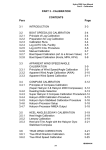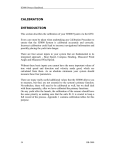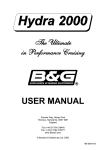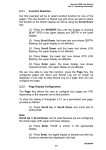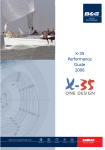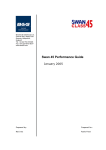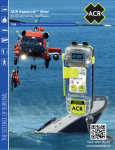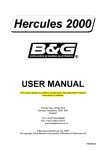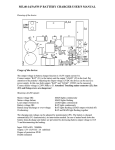Download Herc-Pt 3-Cal_man - Chicago Marine Electronics
Transcript
Hercules 2000 User Manual Part 3 - Calibration PART 3 - CALIBRATION CONTENTS Para Page 3.1 INTRODUCTION 3-3 3.2 3.2.1 3.2.2 3.2.3 3.2.4 3.2.5 3.2.6 3.2.7 3.2.8 BOAT SPEED/LOG CALIBRATION Principle of Log Calibration Preparation for Log Calibration Calibration Runs Log AUTO CAL Facility Log AUTO CAL Procedure Manual Calibration Boat Calibration Referenced to a Known Value Boat Speed Calibration (Knots, MPH, KPH) 3-4 3-4 3-4 3-5 3-5 3-6 3-7 3-7 3-8 3.3 3.3.1 3.3.2 3.3.3 APPARENT WIND SPEED AND ANGLE Principles of Wind Speed/Angle Calibration Apparent Wind Angle Calibration (AWA) Apparent Wind Speed 3-9 3-9 3-11 3-12 3.4 3.4.1 COMPASS CALIBRATION Principles of Compass Calibration (Super Halcyon 3 & Halcyon 2000 Compasses) Heading Node Selection Super Halcyon 3 Compass Calibration Procedure Halcyon 2000 Calibration Procedure Halcyon Gyro Stabilised Compass Calibration Procedure Halcyon Processor Setup Halcyon Processor NMEA output setup 3-13 3-13 3.4.2 3.4.3 3.4.4 3.4.5 3.4.6 3.4.7 3-14 3-15 3-16 3-17 3-18 3-19 3.5 3.5.1 3.5.2 3.5.3 HEEL ANGLE/LEEWAY CALIBRATION Heel Angle Leeway Heel and Trim with the Halcyon Gyro Stabilised Compass 3-19 3-19 3-20 3-21 3.6 3.6.1 3.6.2 TRUE WIND CORRECTION True Wind Direction True Wind Speed 3-22 3-22 3-26 HB-0845-04 3-1 Hercules 2000 User Manual Part 3 - Calibration CONTENTS (Contd.) Para Page 3.7 DEPTH 3-27 3.8 BATTERY VOLTS 3-27 3.9 3.9.1 SEA TEMPERATURE Sea Temperature Offset Calibration 3-28 3-28 3.10 TIMER 3-29 ILLUSTRATIONS Fig No 3.1 3.2 3.3 3.4 3.5 3.6 3.7 Page Calibration Runs Masthead Unit Alignment Leeway Angle Measurement True Wind Direction Upwash True Wind Direction Error Depth Datum 3-5 3-12 3-20 3-22 3-23 3-24 3-27 TABLES Table No Page 3.1 3.2 3-24 3-26 True Wind Angle Correction True Wind Speed Correction HB-0845-04 3-2 Hercules 2000 User Manual Part 3 - Calibration 3.4 COMPASS CALIBRATION 3.4.1 Principles of Compass Calibration (Super Halcyon 3, Halcyon 2000 & Halcyon Gyro Stabilised Compasses) B&G's Autoswing Compasses contain software that allows them to record the magnetic fields in the yacht that are causing the deviation errors. It calculates the corrections every time the boat completes a 540° turn - Super Halcyon 3 or 360° turn - Halcyon 2000, provided the following conditions are met: (a) The 540° turn - Super Halcyon 3 or 360° turn Halcyon 2000 & Halcyon Gyro Stabilised Compass is completed in the same direction. (b) The rate of change of heading does not exceed 3°/s; i.e. the turn should take about 3 minutes to complete. (c) The rate of change of heading must not fall below 0.2 of a degree per second during the 540° turn - Super Halcyon 3, i.e. the 540° turn must not take longer than 45 minutes. (d) The rate of change in heading is constant. (e) Automatic calibration has been utilised by connecting the brown wire from the compass at the junction box. (Super Halcyon 3 only) (f) The compass is installed in a location free from magnetic interference such as iron keels, engines, loudspeakers etc. Consideration should also be given to electrical cables which may carry excessive currents (e.g. navigation lights). (g) The compass is installed in a location as close to the centre line of the boat as possible. Avoid areas such as the fore peak and the sides of the hull where the effects of pitch and roll are at their greatest. (h) On steel hulled vessels, the compass will need to be installed above decks away from the effects of the hull. Ideally, the compass should be installed 4-5m (12-16ft) above deck level. HB-0845-04 3-13 Hercules 2000 User Manual Part 3 - Calibration 3.4.2 Heading Node Selection The Hercules 2000 System can accept heading data from a variety of different sources. These different sources are known as Nodes and allow the system to identify which heading devices are connected to the system. The list below shows the various sources of heading available with its respective address node: Device Node Super Halcyon 3 Compass 5 Halcyon Gyro Stabilised Compass 15 Halcyon 2000 Compass 16 Type PLC Pilot 17 Type ACP Pilot 18 NMEA Heading (NMEA FFD) 96 Enter the required heading node by following the procedure below: (a) Press the Scroll Up key until NAVIGATE is shown in the text, flashing. (b) Press Enter. (c) Press the Scroll Up key again until the display shows COURSE °M flashing. (d) Press Enter. COURSE °M will now stop flashing. (e) Press Scroll CALBRATE. Down until the display shows (f) Press Enter 3 times. The display now shows HDG NO and will display a value which flashes. (g) Use the Scroll Up and Scroll Down keys to change the value to the required setting. (h) Press Enter. (I) Switch the system off, and then back on again to complete the calibration process. Notes (1) Hydra Pilots, Hercules Pilots, HS Pilots and Halcyon FFDs will also require the Heading Node to be set to your desired choice. Refer to the relevant user manual for further information. HB-0845-04 3-14 Hercules 2000 User Manual Part 3 - Calibration (2) 20/20 displays will require Heading to be re-selected. Simply re-select this function and refer to section 5.4.5 for more information. 3.4.3 Super Halcyon 3 Compass Calibration Procedure (1) Check for any magnetic devices placed near the compass, especially ones that are out of their normal places. (2) On a calm day select a stretch of open water with little traffic, (so you will not have to take avoiding action that would ruin the calibration). The flatter the water and the less the wind the easier it will be to meet the conditions for the calibration. (3) Check for any large steel structures nearby that may cause additional erratic deviations. (4) At a speed of about three knots slowly motor the boat through a full one and a half turns (540°), taking six to fifteen minutes to complete the one and a half turns. At this rate the heading should be changing at no faster than one degree every second. Having a watch beside the compass display should considerably assist the helmsman in monitoring the rate of turn. The rate of turn is indicated on the Halcyon Display. (5) When the compass has completed its calibration, the displayed heading will rotate in the opposite direction for 360° and settle on the correct bearing to indicate the calibration is complete. You should continue to turn until you see this. Note If the displayed heading does not reverse, the calibration was discarded because the conditions were not met. You must start again, or try another day when wind and wave conditions are calmer. (6) Eliminate any constant error in heading. These are normally checked for by using shore-based transits, once the error is known it can be eliminated by entering the value into the Hercules under: NAVIGATE → HEADING, CALBRATE → CAL VAL1 For example, the compass was reading 320 degrees and it should read 316, then the value to enter would be -4. HB-0845-04 3-15 Hercules 2000 User Manual Part 3 - Calibration 3.4.4 Halcyon 2000 Calibration Procedure (1) Check for any magnetic devices placed near the compass, especially ones that are out of their normal places. (2) On a calm day select a stretch of open water with little traffic (so you will not have to take avoiding action which would ruin the calibration). The flatter the water and the less the wind the easier it will be to meet the conditions for calibration. (3) Check for any large steel structures nearby, that may cause additional, erratic deviations. (4) Scroll to the NAVIGATE menu and select COMP CAL on the top half of the display. The display shows OFF. (5) Press Scroll Down until the lower text shows CALBRATE flashing. (6) Press the Enter key twice to display START and a default setting of ‘0’. (7) Press the Enter key once and the ‘0’ starts to flash. Use the Scroll Up key to change the value to ‘1’. (8) Press the Enter key. The display now shows 000°. (9) At a speed not exceeding five knots, turn the boat through 360° at a rate not greater than 2-3° per second. The display will show the amount of turn completed so far. Continue to turn the boat until the display shows PASS or FAIL. Notes 1. The compass calibration swing may be aborted at any time. To do this, press the Enter key once. Next, using the Scroll Down key change the value from ‘1’ to ‘0’, and then press Enter to store. The display will now show OFF. 2. The first time the system is switched on, or after a system reset, the Heading will alternate with CAL. This is to indicate to the user that the compass must be calibrated. This will disappear after the compass has been calibrated. HB-0845-04 3-16 Hercules 2000 User Manual Part 3 - Calibration (10) Eliminate any constant error in heading. These are normally checked for by using shore-based transits, once the error is known it can be eliminated by entering the value into the Hercules under: NAVIGATE → HEADING, CALBRATE → CAL VAL1 For example, the compass was reading 320 degrees and it should read 316, then the value to enter would be -4. 3.4.5 Halcyon Gyro Stabilised Compass Calibration Procedure (1) Check for any magnetic devices placed near the compass, especially ones that are out of their normal places. (2) On a calm day select a stretch of open water with little traffic (so you will not have to take avoiding action which would ruin the calibration). The flatter the water and the less the wind the easier it will be to meet the conditions for calibration. (3) Check for any large steel structures nearby, that may cause additional, erratic deviations. (4) Scroll to the MISC menu and select HALCYON on the top display. GYRO will be displayed in the top data line if a Halcyon Gyro Stabilised Compass is connected. (4) Press scroll down until the lower text shows ‘CALIBRATE’ press the ENTER key (6) Press scroll down until the lower text shows CALIBRATE, press the ENTER key, and scroll down to CAL VAL 1, press enter and START will be displayed with ‘0’ as a default value. (7) Press enter and the ‘0’ starts to flash. Use the scroll up key to change the value to ‘1’. (8) Press the Enter key. The display now shows 000°. (9) At a speed not exceeding five knots, turn the boat through 360° at a rate not greater than 2-3° per second. The display will show the amount of turn completed so far. Continue to turn the boat until the display shows PASS or FAIL. If you receive FAIL you must re-calibrate your compass. HB-0845-04 3-17 Hercules 2000 User Manual Part 3 - Calibration Notes 1. 2. The compass calibration swing can be aborted at any time. To do this press the enter key once. Next press the scroll down key and change the value from ‘1’ to ‘0’. You can re-calibrate at any time by following the above procedures. (1) If you have any constant error in your heading, you can correct for this. Enter the value to offset your heading e.g. if your heading displays 100° and it should read 97°, then the value to enter would be –3. The M indicates Magnetic reference headings and a T will indicate True referenced headings. 3.4.6 Halcyon Gyro Processor Setup Data under the MISC > HALCYON heading describes the setup of the Halcyon Gyro Processor, and are as follows: OFF GYRO SYS PASS FAIL xxxº No heading source from either a Halcyon Gyro Stabilised Compass or a B&G system compass Receiving data from Halcyon Gyro Stabilised Compass or NMEA input to Halcyon Gyro Processor Receiving data from a B&G system compass or NMEA input to NMEA FFD or performance processor Calibration swing is complete Calibration swing failed and the compass needs to be re-calibrated. Number of degrees turned during calibration swing HB-0845-04 3-18 Hercules 2000 User Manual Part 3 - Calibration 3.4.7 Halcyon Gyro Processor NMEA output setup NMEA sentence output settings determine what sentences are output with respect to which heading source is available. MISC>HALCYON, CALIBRATE>CAL VAL 2 (NMEA MDE) 0=HDT from Halcyon Gyro Stabilised Compass or NMEA input to Halcyon Gyro Processor 1=HDM from Halcyon Gyro Stabilised Compass or NMEA input to Halcyon Gyro Processor 2=HDG from Halcyon Gyro Stabilised Compass or NMEA input to Halcyon Gyro Processor 3=HDM/HDT from a B&G system [compass or NMEA input], or NMEA input to Halcyon Gyro Processor 4=HDG from a B&G system [compass or NMEA input], or NMEA input to Halcyon Gyro Processor NOTE: Mode 0 is the default value Mode 3 will output the correct sentence depending on configuration. Navigate > Heading, CALIBRATE>CAL VAL 2. 0 = Magnetic 1 = Auto (will set to True if Mag var is available, otherwise will stay in Magnetic) If Mode 4 is selected and magnetic variation is not available then the magnetic heading will be output. 3.5 HEEL ANGLE/LEEWAY CALIBRATION Calibration of Heel Angle and Leeway is only necessary if a Heel Angle Sensor or Clinometer is fitted to the yacht. The fitting of this sensor is highly recommended because it allows the calculation of Leeway and hence course corrected for Leeway which is used in the calculation of Dead Reckoning. 3.5.1 Heel Angle The Heel Angle sensor, or clinometer, should be mounted to read zero when the boat is upright. However any error can be removed by means of the heel angle calibration. HB-0845-04 3-19 Hercules 2000 User Manual Part 3 - Calibration On a calm day with the boat lying at slack warps in the dock, head to wind, all the gear stowed in its normal place, and anyone onboard standing on the centreline the heel angle should be recorded, under these conditions it should be zero, any error can be taken out by the heel angle calibration, by adding or subtracting the error from the existing calibration. Heel angle calibration is to be found in the system menu under: PERFORM → HEEL, CALBRATE → CAL VAL1 3.5.2 Leeway Calibrating leeway is a notoriously difficult thing to do; it may be easier, and as accurate, to consult the yachts designer who may have a theoretical value for leeway coefficient, as it is to try to measure it. Should that not be possible then we can calculate the Leeway coefficient from the following formula: L = KxH Bs x Bs where, Bs = Boat Speed K = Leeway Coefficient H = Heel Angle L = Leeway Angle K then is the constant that needs to be entered, and to establish a value for leeway coefficient we need to measure the leeway angle at a particular heel angle and boat speed shown in Fig 3.3 below. Back Bearing 80˚ g-1 adin Leeway Angle He se Cour ding Hea ers Mark Fig 3.3 Leeway Angle Measurement The idea is to sail on a steady course and drop markers over the stern at regular intervals, the angle between them and the HB-0845-04 3-20 Hercules 2000 User Manual Part 3 - Calibration centreline of the yacht is measured with a hand bearing compass, and hence leeway angle is measured. Whilst this is happening the boat speed and heel angle should be noted at intervals and an average calculated. These values can then be used to calculate the leeway coefficient from the following expression. K = L x Bs x Bs H Obviously the flatter the water and the steadier the breeze the more likely this is to be successful, but even in perfect conditions it is difficult, to say the least. Once you have the leeway coefficient 'K' then it is entered into the system under: NAVIGATE → LEEWAY, CALBRATE → CAL VAL1 3.5.3 Heel and Trim angle with the Halcyon Gyro Stabilised Compass. The heel and trim information from the Halcyon Gyro Stabilised Compass is displayed in the PERFORM menu. The H symbol will be placed on left indicating heel to port and on the right for heel to starboard. The display will always be shown to 1 decimal point The U symbol on the left indicates that the bow is up, while a d will be shown indicating bow down. The display will always be shown to 1 decimal point Both heel and trim have an offset calibration to allow for any constant errors, adding or subtracting from CAL VAL 1 will correct this. PERFORM → HEEL, CALIBRATE → CAL VAL 1 PERFORM → TRIM, CALIBRATE → CAL VAL 1 If you have heel and trim sensors connected to your system as well as a Halcyon Gyro Stabilised Compass then the Heel and Trim from the Compass will be used by default. If you wish to use your external sensors then set CAL VAL 2 to ‘0’. PERFORM → HEEL, CALIBRATE → CAL VAL 2 PERFORM → TRIM, CALIBRATE → CAL VAL 2 HB-0845-04 3-21 Hercules 2000 User Manual Part 3 - Calibration 3.6 TRUE WIND CORRECTION It is finally time to go sailing and begin the calibration of the true wind direction and speed. 3.6.1 True Wind Direction The need for further calibration of true wind direction will become clear as soon as you go sailing. The true wind might vary in direction from tack to tack, independently of any wind shifts. This phenomenon has come to be known as the true wind 'tacking'. The reason it happens is because the true wind angle that the instruments are calculating is wrong. We can see the direct connection between true wind angle and direction in Fig 3.4 below. True Wind Direction =280˚ Heading =240˚ TWA =40˚ Fig 3.4 - True Wind Direction The reason for this is a variety of errors that enter into the calculation of true wind angle from apparent wind angle, one of the largest of which is Upwash, an aerodynamic effect which is shown in Fig 3.5 - Upwash. HB-0845-04 3-22 Hercules 2000 User Manual Part 3 - Calibration MHU Fig 3.5 - Upwash In Fig 3.5 the apparent wind that the instruments measure is actually deflected from the 'real' apparent wind angle which we need to calculate the true wind. Add to this the various twisting effects of the mast and the Masthead Unit, and we get some idea of the problems involved. The hardest part is that it is easy to see the true wind direction 'tack' as little as 2-3 degrees, which would mean the correction factors being as accurate as 0.5 degree, or about 1%. This is why calibration of the true wind has been so difficult historically, because the approach has always been to research these effects and write formulas that automatically correct them for the user. The Hercules 2000 takes a whole new approach because our research has shown that the EFFECTS ARE NOT CONSTANT. For any particular windspeed the correction needed for all these errors has to be different from day to day, not least because of the problems of wind gradient we discussed earlier. So what is required is not yet another attempt to automatically correct these errors, but a simple, easy-to-use system whereby you can correct them yourself on a day-to-day basis. And this is what the Hercules 2000 provides. HB-0845-04 3-23 Hercules 2000 User Manual Part 3 - Calibration How does it work? As we have seen the problem stems from the true wind direction 'tacking' as the boat manoeuvres from tack to tack. So what we need to know is the error that the true wind suffers in any manoeuvre, be it a normal upwind tack, a reach to reach tack, or a downwind gybe. Once you know the error, and the windspeed you had at the time, then we can enter it as a correction. What we are aiming to do is build up a table of corrections similar to that shown in Table 3.1 - Example True Wind Angle Correction Table. Wind Angle 5 2 3 0 Upwind Reaching Downwind 10 5 5 0 True Wind Speed 15 20 3 2 6 5 0 0 25 1 4 0 30 1 3 0 Table 3.1 - Example of True Wind Angle Correction Table The table initially contained in the Hercules 2000’s memory is empty and we need to discover and enter the relevant corrections for true wind direction. To see how we work out the correction we will look at an on the water situation, from which we can determine some general rules. Starboard Tack true wind direction 200˚ Heading =160˚ 10˚ 40˚ Port Tack true wind direction 210˚ 40˚ Heading =250˚ Fig 3.6 -True Wind Direction Error In Fig 3.6 we see a typical situation, sailing on port tack, upwind, in ten knots, the true wind direction reads 210. We tack over onto starboard and settle the boat down, now the true wind direction reads 200. There is a ten degree error tack to tack. The true wind direction should read 205 on both tacks. To correct the true wind angle so that the true wind direction reads 205 on both tacks, we HB-0845-04 3-24 Hercules 2000 User Manual Part 3 - Calibration need to add 5 degrees to the true wind angle. So for a general rule we can say: If the wind direction is higher on port tack than starboard, we need to ADD HALF the DIFFERENCE between the readings on the two tacks, to the true wind angle. And the converse will apply: If the wind direction is lower on port tack than on starboard, we need to SUBTRACT HALF the DIFFERENCE between the readings on the two tacks, to the true wind angle. This works whether you are tacking upwind, gybing downwind or tacking reach to reach. All we need to do now is tell the Hercules 2000 the correction value at each of the points in the table. The true wind correction facility, is found in the menu under: WIND → TRUE W/A, CALBRATE → CORRECTION This then allows you to scroll through all the correction values in the table (using Scroll Up or Scroll Down) until you find the one where you wish to enter a correction, in our example above we would be looking for "upwind, 10 knots". Once you have scrolled through to this, a press of the Enter Key will allow you to enter the required number of degrees correction (i.e. +5) using the Scroll Up and Scroll Down Keys to increase/decrease the value accordingly. A final press of the Enter Key stores this to the Hercules 2000. In the early stages of calibration when the table is nearly empty, it is important to enter the same value of correction to the windspeeds either side of the one you are using. This is to avoid the true wind direction jumping in value when the wind speed drops or increases outside the range you are correcting. As your table gets closer to being finished you will be able to make individual changes, because the other corrections will be accurate enough to avoid any strange "step" changes as the true wind speed varies. For this reason it is very important to enter all these corrections into a Calibration Chart (see Appendix 1). This way you will notice any big gaps in the correction table where you have entered no values at all. HB-0845-04 3-25 Hercules 2000 User Manual Part 3 - Calibration Initially you may require to do some sailing trials, and it is advisable to get into a pre-start routine of carrying out each of the tacking manoeuvres before the start of a race, correcting any problems as they arise. Finally, the most important thing is to record all these entries in the Calibration Charts provided in Appendix 1. 3.6.2 True Wind Speed The True Wind Speed suffers from another, mainly aerodynamic, problem, where it tends to over-read downwind because of acceleration of the airflow over the top of the mast. It is possible to correct for this by applying a downwind correction to the true wind speed. This correction is applied at 180 degrees true wind angle and linearly interpolated to zero correction at 90 degrees true wind angle. The routine here is to bear away quickly from close-hauled to dead-downwind and watch the increase in true wind speed. Then the difference is entered as the negative correction. The table will look similar to the one shown in Table 3.2 - True Wind Speed Correction. Wind Angle Downwind 180 5 0 True Wind Speed 10 15 20 25 -0.5 -1.0 -1.5 -2.0 30 -2.5 Table 3.2 - Example of True Wind Speed Correction Table The corrections are found in the menu under: WIND → TRUE W/S, CALBRATE → CORRECTION They are entered in the same way as the true wind direction corrections. It is crucial to keep a full record of the process. HB-0845-04 3-26 Hercules 2000 User Manual Part 3 - Calibration 3.7 DEPTH A typical transducer installation is through the hull at a suitable position between the water line and the bottom of the keel. A DATUM (offset value) can be set, such that the depth display refers to either the water line or the keel line. Transducer Add for Waterline Subtract for Keel Fig 3.7 - Depth Datum The datum is entered under: DEPTH → DEPTH, CALBRATE → DATUM 3.8 BATTERY VOLTS The Hercules 2000 monitors the yacht's battery supply and can be called up on any display, giving a reading in volts. This is calibrated by the manufacturer and should not require adjustment except in exceptional circumstances or after a system reset. If it is necessary to calibrate this function a suitable voltmeter is required. The calibration value is found in the menu under: MOTOR → VOLTS, CALBRATE → CAL VAL1 Using the independent voltmeter, measure the battery supply at terminals 18 (+) and 17 (-) at the Computer Unit connection block. CAL VAL1 is altered to match the value from the voltmeter. HB-0845-04 3-27 Hercules 2000 User Manual Part 3 - Calibration 3.9 SEA TEMPERATURE If a suitable temperature sensor is fitted, the Hercules 2000 will monitor the current sea temperature. The paddle-wheel has a sensor incorporated within it, in this case no further action is required. If the sensor is a totally independent fitting (B&G part no. 22300-027) then it is necessary to change the sensor selection value. This value is found in: TEMP → SEA TEMP, CALBRATE → CAL VAL1 (SENSORS) The default selection value is a 1, we need to change it to a 2. 3.9.1 Sea Temperature Offset Calibration To calibrate SEA TEMP C or SEA TEMP F proceed as follows: (1) Select SEA TEMP C on upper half on FFD display (2) Press Scroll Down until the lower text shows CALBRATE flashing (3) Press Enter, the lower text now shows CAL VAL 1 flashing (4) Press Scroll Down, the lower text now shows CAL VAL 2 flashing (5) Press Enter, the lower text now shows OFFSET C (6) Press Enter, the lower text now shows OFFSET C flashing and by use of Scroll Up/Down the reference temperature may be entered. (7) Press Enter, the offset value is accepted and the upper display will show the adjusted measured temperature. Similarly the above calibration can be carried out if SEA TEMP F is initially selected. HB-0845-04 3-28 Hercules 2000 User Manual Part 3 - Calibration The offset value is automatically converted so that both degrees C and F are adjusted correctly. 3.10 TIMER The Timer uses a stable quartz crystal to provide an accurate time base when calibrated. The calibration is set when the unit is manufactured and should not normally require further adjustment. If adjustment is necessary the calibration can be found as follows: TIME → TIMER, CALBRATE → CAL VAL1 The Calibration value is the number of seconds correction required a day. If the timer is gaining then the number of seconds it is gaining a day should be subtracted from the current calibration value. If the timer is losing the number of seconds lost a day should be added to the current calibration value. HB-0845-04 3-29



















